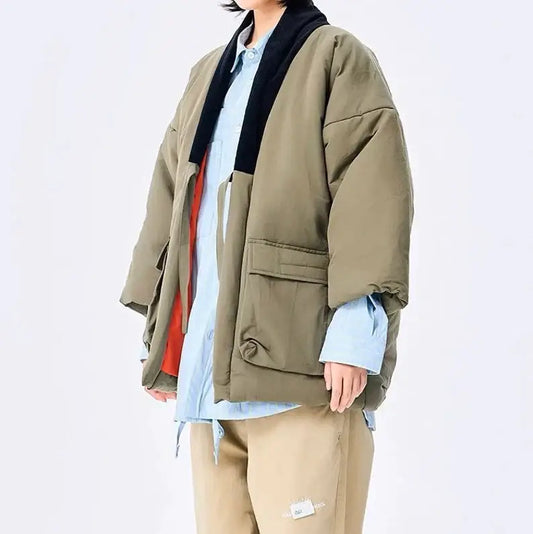Men's Hanten - Traditional Winter Japanese Attire
Hanten traces its roots back to the Edo period (1603-1868) of Japan. During this time, Japan saw an urban boom, with merchants and artisans becoming prominent societal figures. The working class required clothing that was both functional and indicative of their status. Enter the Hanten – a short winter coat designed to provide warmth. Over time, it evolved from a utilitarian piece of clothing to a more decorative one, capturing the essence of its wearer’s profession or status.At its core, the Hanten was designed for warmth. It’s typically padded with cotton and has a straight-cut design, making it perfect for layering over other clothing. Its simple construction, featuring a collar , open front, and tie closures, allows for ease of movement, making it practical for both work and daily wear.
The Hanten is also characterized by its length, which usually extends to the hips. This shorter design was intentional, allowing the wearer to move freely without the constraints of a longer coat. This was especially crucial for workers and artisans who needed to perform tasks without their clothing becoming a hindrance.
Moreover, the Hanten's sleeves are of a unique design. Unlike the more formal kimono, which has long, hanging sleeves, the Hanten sports shorter, more pragmatic sleeves, apt for hands-on tasks. This demonstrates the garment's inherent design focus on functionality for the working class.
While the primary purpose of the Hanten was functionality, style was never compromised. Over time, as the garment permeated through various strata of Japanese society, it began to reflect the aesthetic choices and individualities of its wearers.
One of the most distinctive stylistic features of the Hanten is its intricate patterns and designs. Some Hanten are adorned with family crests, others with symbols representing a particular trade or craft. For instance, a Hanten worn by a fireman in historical Japan might feature motifs related to fire prevention, showcasing his profession.
The choice of fabric and color also varies widely. While indigo was a popular choice due to its durability and symbolic ties to protection, various shades of browns, blacks, and even vibrant hues can be found, each telling a unique story about its wearer.
While Japan has modernized and western clothing has become the norm for everyday wear, the Hanten has not been relegated to the annals of history. Contemporary Japanese designers have drawn inspiration from this traditional garment, incorporating its elements into modern fashion. As a result, one might see Hanten-inspired jackets on the streets of Tokyo, a testament to the enduring legacy of this piece.
Furthermore, the Hanten continues to be worn during festivals and cultural events, connecting present-day Japan with its rich history. This garment serves as a reminder of a bygone era, and yet, its timeless appeal ensures that it remains relevant even today.







